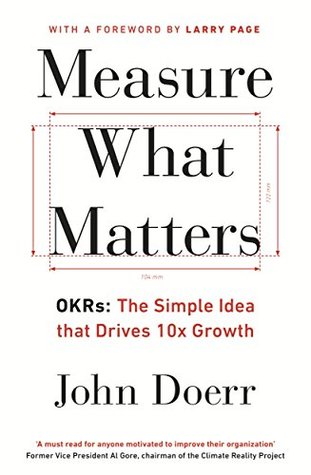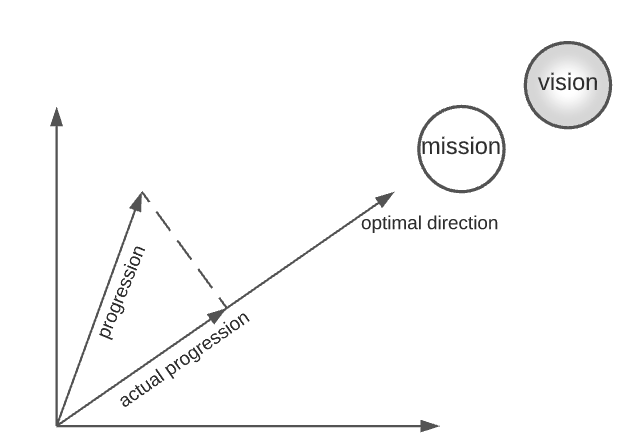Measure What Matters
Measure what matters is a great book written by the OKR advocator John Doerr, who learned OKR while worked at Intel in the 1970s and promoted it to be widely used in Google ~2000s.

Before OKR is widely known, there are many discussion around whether vision or planning are more important or execution is more important. MBAs are favored on describing the big pictures or directions, while the doers focus on executions. The famous quote from Linus Torvalds, “Talk is cheap, show me the code”, is a good example for the mindset of the doers.
In my understanding, vision, direction, planning, and execution are all important. Execution is the 1, while vision and planning are the 0’s behind it. Without others, we can hardly make any significant achievement efficiently, and without execution, we cannot achieve anything at all.

OKR (Objectives and Key Results) is an elegant tool that combines the vision, planning, and execution.
Objectives defines the WHATs. It expresses the goals and the intents. A good objectives should be aggressive yet realistic. It must be tangible, objective, and unambiguous; and should be obvious to a rational observer whether an objective has been achieved or not. Additionally, the successfully achievement of an objective must provide clear value for the entity.
Key results defines the Hows. It expresses measurable milestones which will advance objectives in a useful manner to their constituents. A clear key result must describe the outcomes instead of activities and must include evidence of completion.
Cross-team OKRs should include all the groups who must materially participate in the OKR, and OKRs committing to each group’s contribution should appear explicitly in each such group’s OKRs.
In addition to set the process of daily operation, OKR can also help shape a healthy culture of an organization. An OKR culture is an accountable culture. You don’t push toward a goal just because the boss gave you an order. You do it because every OKR is transparently important to the company, and to the colleagues who count on you. An OKR culture can also help people from doing the (wrong) things right to doing the right things.
摘要
Part One: OKRs in Action
1. Google, meet OKRs
OKRs is short for Objectives and Key Results. It is a collaborative goal-setting protocol for companies, teams, and individuals. Now, OKRs are not a silver bullet. They cannot substitute for sound judgement, strong leadership, or a creative workplace culture. But if those fundamentals are in place, OKRs can guide you to the mountaintop.
- An OBJECTIVE is simply WHAT is to be achieved, no more and no less. Objectives are significant, concrete, action oriented, and inspirational.
- KEY RESULTS benchmark and monitor HOW we get to the objective. Effective KRs are specific and time-bound, aggressive yet realistic. They are also measurable and verifiable.
An objective can be long-lived, rolled over for a year or longer, key results evolve as the work progresses. Once they are all completed, the objective is necessarily achieved.
Hard goals drive performance more effectively than easy goals. Specific hard goals produce a higher level of output than vaguely worded ones.
2. The father of OKRs
It almost doesn’t matter what you know. It’s what you can do with whatever you know or can acquire and actually accomplish that tends to be valued here.
A limit of three to five OKRs per cycle leads companies, teams, and individuals to choose what matters most. In general, each objective should be tied to five or fewer key results.
4. Superpower #1: Focus and commit to priorities
What are our main priorities for the coming period? Where should people concentrate their efforts? An effective goal-setting system starts with disciplined thinking at the top, with leaders who invest the time and energy to choose what counts.
If an objective is well framed, three to five KRs will usually be adequate to reach it. Too many can dilute focus and obscure progress. Besides, each key result should be a challenge in its own right.
The more ambitious the OKR, the greater the risk of overlooking a vital criterion. To safeguard quality while pushing for quantitative deliverables, one solution is to pair key results — to measure “both effect and counter-effect”.
Key results should be succinct, specific, and measurable.
7. Superpower #2: align and connect for teamwork
Because OKRs are transparent, they can be shared without cascading them in lockstep.
To avoid compulsive, soul-killing over-alignment, healthy organizations encourage some goals to emerge from the bottom up.
Micro-management is mismanagement. A healthy OKR environment strikes a balance btween alignment and autonomy, common purpose and creative latitude.
10. Superpower #3: track for accountability
One underrated virtue of OKRs is that they can be tracked and then revised or adapted as circumstances dictate.
To help execute OKRs, a best practice is to designate one or more OKR shepherds.
Whenever a key result or objective becomes obsolete or impractical, feel free to end it midstream.
Wrap-up OKRs:
- Scoring: Mark what we’ve achieved and address how we might do it differently next time. The simplest and cleanest way to score an objective is by averaging the percentage completion rates of its associated key results.
- Self-assessment: In evaluating OKR performance, objective data is enhanced by the goal setter’s thoughtful, subjective judgment.
- Reflection: The key to satisfaction is to set aggressive goals, achieve most of them, pause to reflect on the achievement, and then repeat the cycle.
12. Superpower #4: stretch for amazing
OKRs push us far beyond our comfort zones. They lead us to achievements on the border between abilities and dreams.
Leaders must convey two things: the importance of the outcome, and the belief that it’s attainable.
Part Two: The New World of Work
15. Continuous performance management: OKRs and CFRs
Distorted recency bias, burdened by stack rankings and bell curves, these end-of-year evaluations can’t possibly be fair or well measured.
Continuous performance management. It is implemented with an instrument called CFR:
- Conversation: An authentic, richly textured exchange between manager and contributor, aimed at driving performance.
- Feedback: Bidirectional or networked communication among peers to evaluate progress and guide future improvement.
- Recognition: Expressions of appreciation to deserving individuals for contributions of all sizes.
People are more likely to feel fulfilled when they have clear and aligned targets. They’re not wandering and wondering about heir work; they can see how it connects and helps the organization.
OKRs reflect a person’s most meaningful work, they’re a source of reliable feedback for the cycle to come. But when goals are used and abused to set compensation, employees can be counted on to sandbag. They start playing defense; they stop stretching for amazing. They get bored for lack of challenge. And the organization suffers most of all.
Topics of one-on-ones:
- Goal setting and reflection.
- Two-way coaching.
- Career growth.
- Lightweight performance reviews.
18. Culture
Culture is the common language that allows for individuals in an organization to be sure they’re all talking about the same thing — and that what they’re talking about has meaning. Beyond that, culture establishes a common framework for decision making. In its absence, people are at a loss for how to make key functions replicable and scalable.
An OKR culture is an accountable culture. You don’t push toward a goal just because the boss gave you an order. You do it because every OKR is transparently important to the company, and to the colleagues who count on you.
From doing the things right to doing the right things.
21. The goals to come
Ideas are easy, execution is everything.

Leave a comment